Despite the abundance of new communication channels in this ever-changing market, it is no secret that email remains the cornerstone of communication and one of the most powerful tools in a marketer’s arsenal.
What marketing professionals sometimes fail to see is how leveraging UX insights and principles can help them dive deeper into the psychology of email engagement. While traditional email marketing focuses mainly on the content of the message, marketers and businesses alike often fail to explore the other side of the same coin, the user engagement with this content.
Understanding email engagement
Email engagement is the extent to and the way the recipient of an email will interact with it. While opening an email will signify some sort of engagement, to begin with, there are an array of interactions that can happen after that. The email recipient can read the copy, click on the links or CTAs provided, complete an action such as downloading an asset, making a purchase, or forwarding the email to someone else! All these interactions denote that the user has some level of interest and has engaged with the email.
Putting our UX hats on, we are safe to say that tracking and analyzing email engagement is critical in understanding how current emails are performing. There are a host of metrics that can be used to track email engagement.
Open rates, a metric that shows how many users are opening your email, and click-through rates, which calculate the percentage of users that have clicked on the links of your emails, are the two main metrics to gauge the overall effectiveness of your emails.
Conversion rates are another great metric to keep track of, especially if there is a particular desired goal or action that needs to be completed on the user’s part.
Last but not least, keeping a tally of the times that the email has been forwarded to other users is an excellent way to track referrals. All the above metrics can provide you with invaluable insights into email engagement and uncover user behaviors, which will help you refine and optimize your email campaigns.
The importance of email engagement
According to HubSpot, there are 4 billion daily email users, while 37% of brands are increasing their email budget. With email engagement having a knock-on effect on all these metrics and effectively on the overall success of your email campaign, its importance is paramount. High levels of engagement will lead to higher open rates, improved click-through rates, and, consequently, enhanced conversion rates.
of brands are increasing their email budget
It’s handy to think of an email as an interface with different elements. From the copy of the subject line and the subheader to the personalization aspects and everything in between, you have the chance to achieve higher email engagement by tracking, analyzing, and testing each one of these elements.
Apart from the individual metrics, email engagement can work wonders for the overall success of your email campaigns and boost your email list growth in the long term. Higher engagement rates translate into greater deliverability and can boost the sender's reputation.
The psychology of email engagement
Leveraging UX can help you deep dive into the psychology of email engagement and uncover not only the underlying reasons for user engagement but also ways to influence it. Here are some of the cognitive triggers that you need to be aware of:
1. Cognitive load
Cognitive load is the effort that is needed for our brain to process information or perform a task. As a rule of thumb, using a simple email design and writing clear copy, preferably divided into chunks, can significantly reduce the user’s cognitive load. As a result, the user can absorb the information effortlessly, boosting the chances for greater interaction.
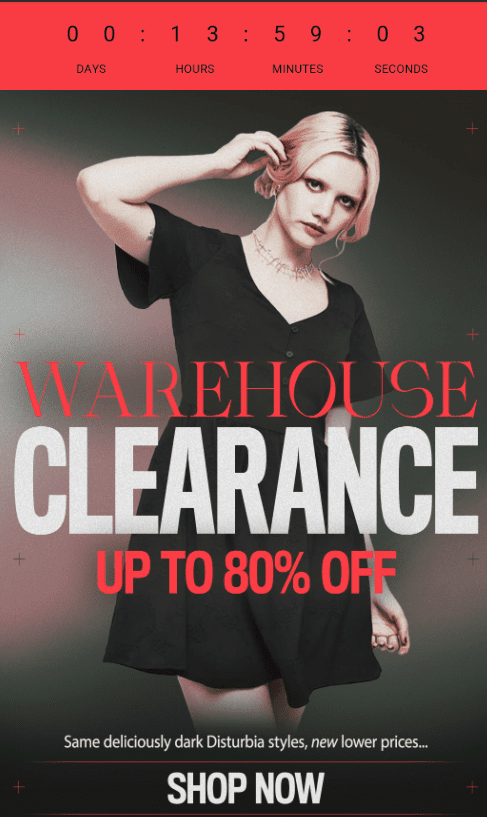
(Source: Email from Disturbia)
2. Trust indicators
Users need to feel safe to engage, and trust indicators help create a safe space. A great way to boost trust is by adding social proof to your emails, which can take the form of a review or a testimonial. Another great tip is always to use clear CTAs so that the user knows what to expect once they click on the link.

(Source: Email from World of Watches)
3. Personalization
Creating relevant and relatable email experiences that resonate with your users will work wonders on email engagements. Personalization goes beyond adding your user's first name. A good way to make your emails more relatable is to segment your users into meaningful groups with common characteristics and needs and tailor the email experience for each of these groups.
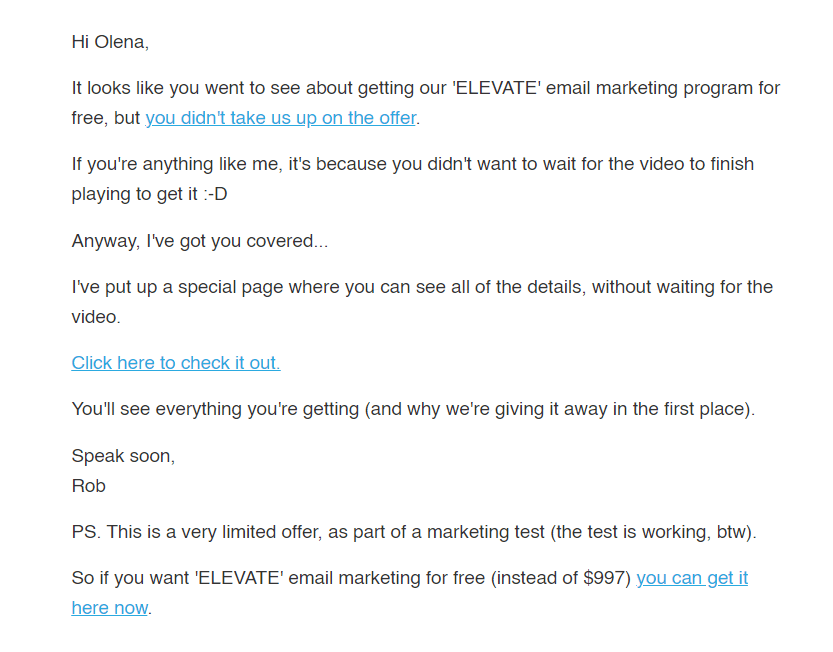
(Source: Email from Email Marketing Heroes)
4. Curiosity gap
Curiosity is another human trait that you can tap into to boost email engagement. A golden rule is to create thought-provoking subject lines and pre-headers that do not give away too much. This will spike the curiosity of the user and prompt them to open the email or click to read more!
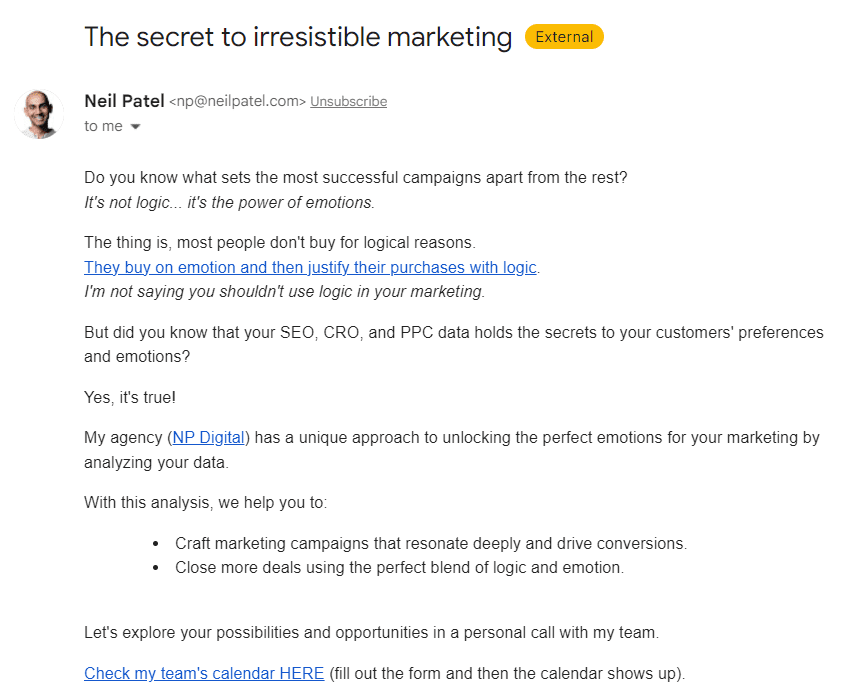
(Source: Email from Neil Patel)
5. FOMO
The fear of missing out is real and is another psychological trigger that can skyrocket your email engagement levels! Human beings are wired to fear missed opportunities, so by creating a sense of urgency or exclusivity with your email, you can tap into this trigger and boost your email engagement.
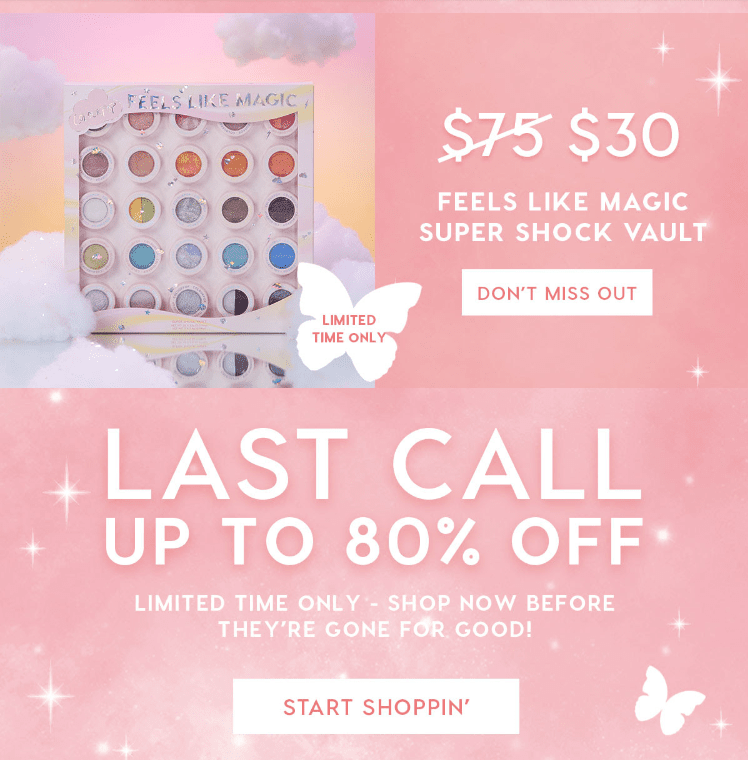
(Source: Email from ColourPop Cosmetics)
UX and its role in boosting email engagement
Ultimately, leveraging UX when designing email experiences can help you craft invaluable, relatable content while creating a visually pleasing and meaningful email experience.
Here are the 4 core principles of effective UX email design:
1. Clarity
Clarity is the alpha and the omega of email design. The email copy should be easy to comprehend so the recipient can understand the main message. Equally, the call to action of the email should guide the users on the action that needs to be taken.
2. Accessibility
Readability and accessibility guidelines are of utmost importance in email design. Some of the best accessibility practices include sufficient color contrast, usage of semantic elements, larger font sizes, and proper line spacing. However, UX insights tell us that it’s often advisable to test email designs on usability testing platforms with target recipients to guarantee inclusiveness and accessibility.
3. Responsiveness
You should always ensure that your email displays and functions as expected on various devices, browsers, and operating systems, as this can cause hiccups for users, leading to lower email engagement.
4. Relevance
Keeping your email content relevant and making it relatable to your users is another UX principle that should be applied to email design. Make sure to tailor your emails based on your user’s data and past behaviors, increasing in this way the likelihood of interaction.
Best user experience practices for better email engagement
Crafting email experiences using best UX practices will undoubtedly lead to higher engagement rates. These golden rules can help you captivate your audience’s attention and guide them through an intuitive and smooth user journey toward the desired action or goal:
1. Design hierarchy
Design hierarchy refers to the way that the information and elements of a particular design are organized in a structured and hierarchical way. Clear information structures are the first golden rule of UX when it comes to email engagement. Marketers can leverage the layout and design of the email to guide the reader through the copy and the actions that need to be taken.
For instance, they should use clear and scannable content followed by preferably one clear call to action directing the user to take the desirable action. Additionally, readability should be top of mind, so fonts and colors should be used with caution and accessibility in mind.
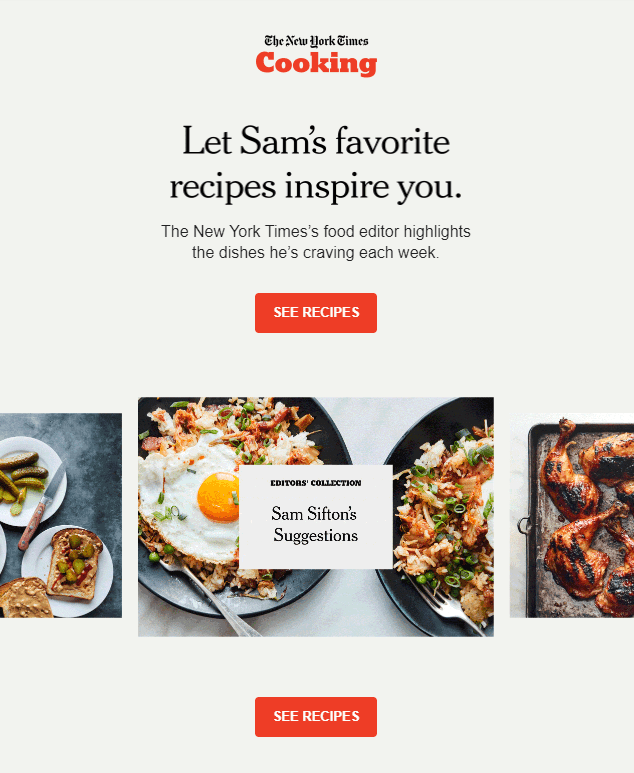
(Source: Email from NYT Cooking)
2. Whitespace
Decluttering your email design and having ample whitespace is a no-brainer when it comes to applying good UX practices to your email design. This will reduce the cognitive load of the user and will promote readability. To achieve this, be mindful of the use of whitespace between paragraphs, images, or other design elements. But be careful! Try to strike a balance between taking up too much whitespace and over-cluttering your email with copy and design elements! You want to grab your user’s attention while fostering readability and scanability.
3. Clear CTA
When crafting the email customer journey, always try to streamline it by minimizing the number of steps they need to take to reach the desired goal. Always make sure that the microcopy of your CTA is clear and that the user will land on the appropriate landing page.
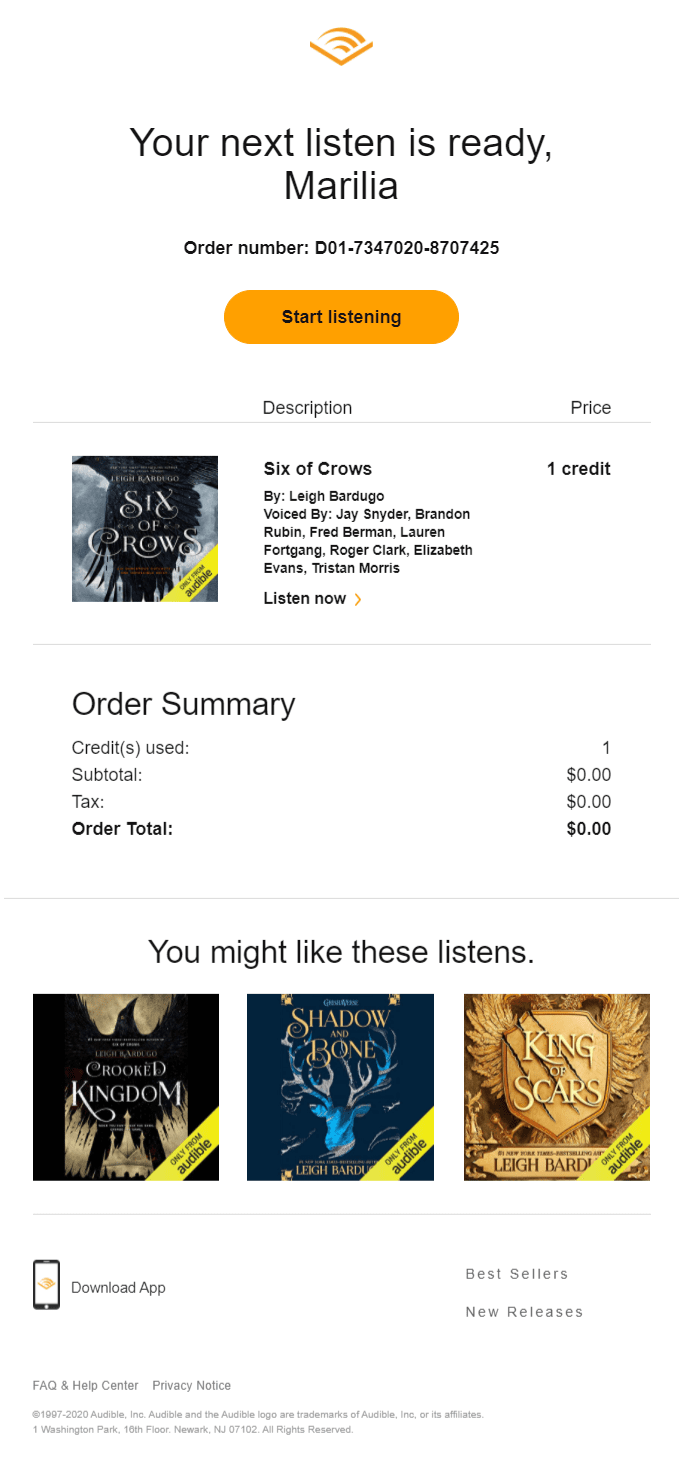
(Source: Moosend)
4. Interactive elements
Incorporating interactive content like GIFs or videos can have a great effect on email engagement and grab the attention of your users, which can lead to a higher likelihood of response. This is another great way to replace lengthy copy while conveying your desired message.
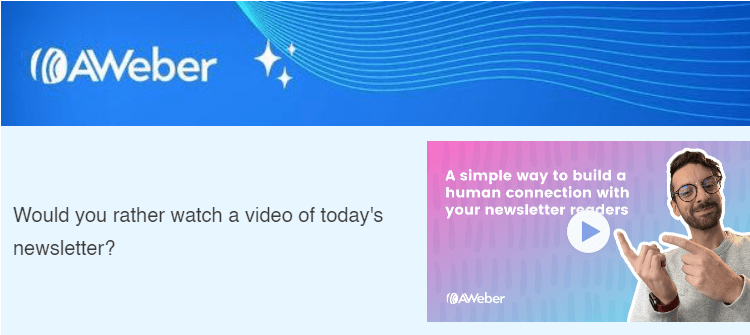
(Source: Email from AWeber)
5. Feedback mechanism
Adding feedback mechanisms to emails is another way to incorporate UX practices into your email campaigns. This can take the form of short surveys or polls to gauge engagement and learn invaluable insights about your users’ preferences!
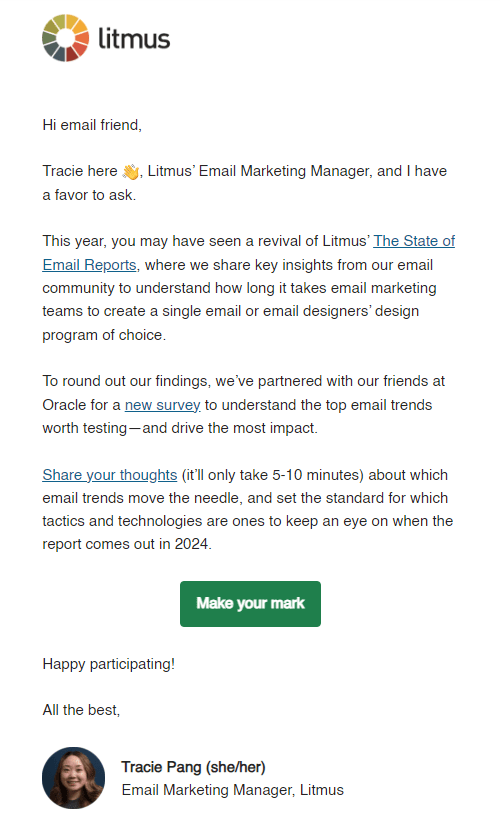
(Source: Email from Litmus)
6. Optimized load time
Lastly, optimize the load time of your email to ensure swift access and avoid friction, as slow-rendering emails can cause frustration and heavily reduce the likelihood of any sort of engagement. Optimizing the load time for your email can ensure that the readers can access and interact with your email as soon as they receive it. The top tips when it comes to load time optimization are the use of web-safe fonts, the use of optimized images, and the limited use of animated content.
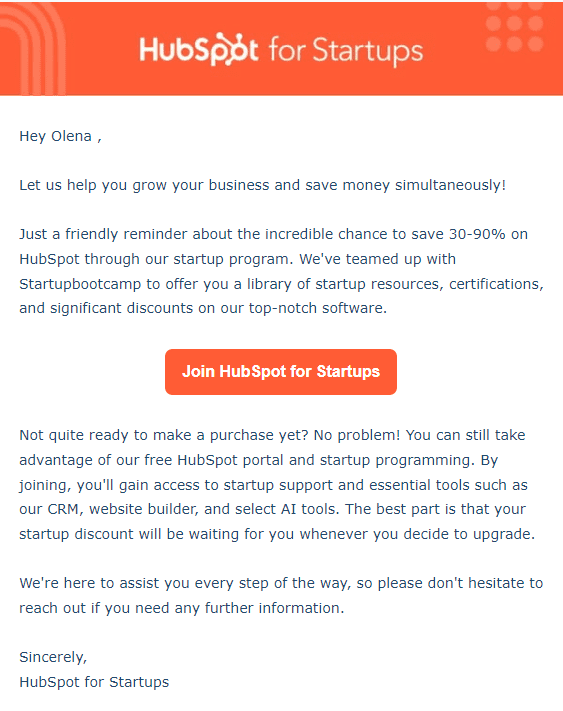
(Source: Email from HubSpot for Startups)
Common mistakes to avoid in email UX design
Here are a few common pitfalls to avoid when crafting your email design. By avoiding those common mistakes, you can ensure your email design is user-centered and that it is optimized for engagement:
1. Overwhelming the user
One of the most common mistakes when it comes to email design is overwhelming the user with far too many CTAs, distracting visuals, and lengthy copy. Cluttered emails can confuse and frustrate users, leading to the opposite results.
2. Lack of mobile optimization
With mobile users on the rise, failing to optimize your design for mobiles is another major pitfall. Make sure to design for mobile-first and ensure responsive design across various devices.
3. Ignoring accessibility standards
Failing to adhere to accessibility standards is yet another common mistake that can exclude a big portion of your users from your message. Make sure you are not overlooking the industry-approved standards when it comes to color contracts and font size!
4. Overuse of sales language
Tempting as it might be to try to sell hard your product or service, refraining from using aggressive sales language without providing value to the user is another common mistake when it comes to crafting emails. Overuse of sales language can alienate your audience, leading to decreased trust and, hence, lower engagement.
On top of that, there is the peril of your email domain being classified as spam! Always add something of value to the user to maintain interest and engagement, and make sure to balance out any promotional content!
5. Ignoring user behavior data
Last but not least, some businesses tend to ignore user behavior data and are missing a huge opportunity to engage at a deeper level with their audiences. Always analyze metrics and tweak your email campaigns based on data to achieve better engagement.
Wrapping up
In today's ever-changing market, email remains one of the most powerful marketing tools. Businesses that do not harness the power of UX insights to create more impactful emails are missing a great opportunity to ripe the fruits of the psychology of email engagement.
By understanding the close-knit relationship between UX and email engagement, marketers can also leverage various cognitive triggers to craft more relatable and compelling email experiences in line with the golden rules of UX design.




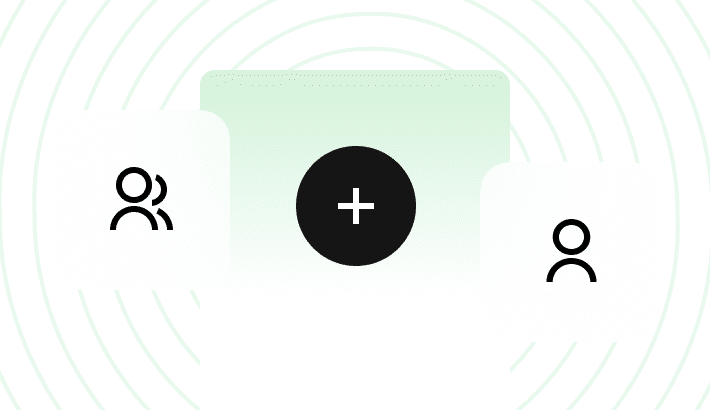
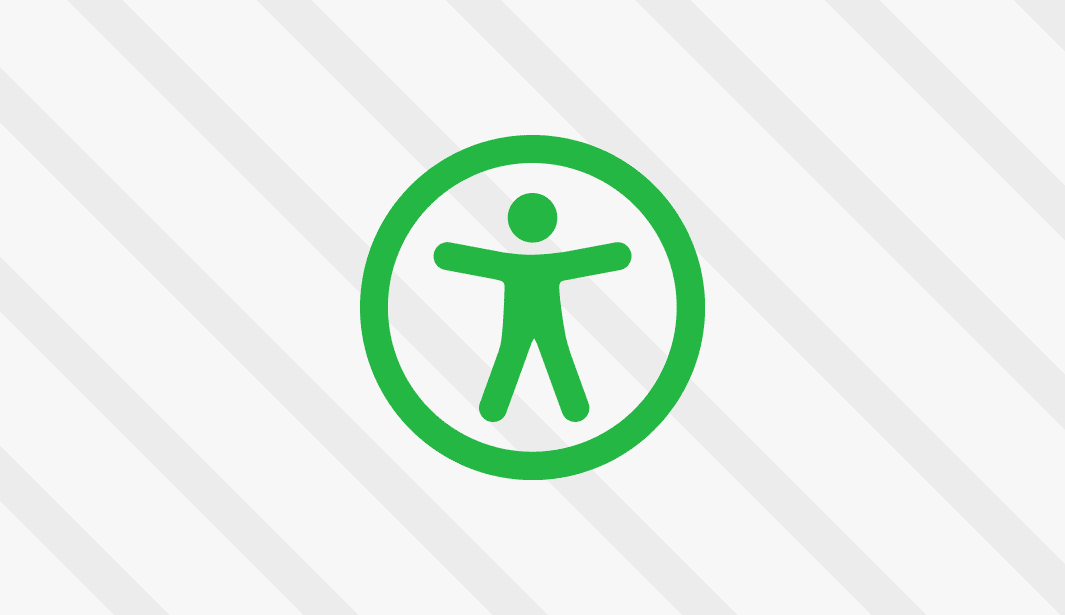



0 comments